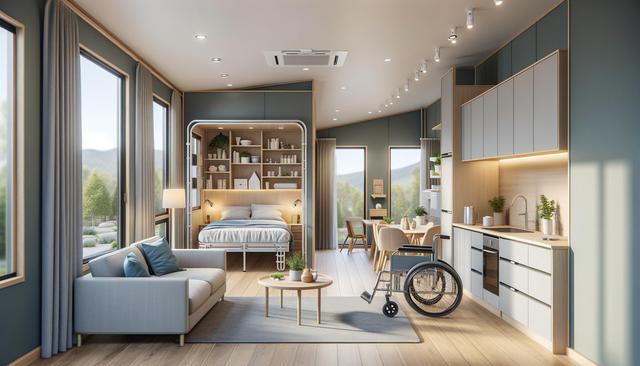Living Room: Comfort Meets Accessibility
The living room is often the hub of a home, and for seniors, it should be both welcoming and functional. In modular homes, living rooms can be customized to reduce obstacles and enhance mobility. Open floor plans are especially beneficial, allowing for easy navigation with walkers or wheelchairs. Furniture selection also plays a key role: chairs and sofas with firm cushions and supportive armrests make standing up easier. Additionally, incorporating non-slip flooring materials can reduce the risk of falls.
Technology integration provides added convenience and safety. Consider the following features:
- Smart lighting with motion sensors to reduce the need for manual switches
- Home monitoring systems that alert caregivers in case of an emergency
- Voice-activated assistants for simple control of lighting, music, and communication
Windows with low sills and wide openings allow natural light to fill the space, improving mood and visibility. Thoughtful placement of electrical outlets and switches at reachable heights also makes daily life easier.
Kitchen: Safe and Efficient Design
The kitchen is a critical area in any home, and in modular homes for seniors, it must be designed with safety and ease of use in mind. Cabinets with pull-out shelves and drawers offer easier access to items, reducing the need for bending or reaching. Installing appliances at counter height—such as wall ovens and microwaves—can also prevent strain or injury.
Other useful modifications include:
- Induction cooktops that cool down quickly to prevent burns
- Lever-style faucet handles for easier operation
- Contrasting colors between countertops and cabinets to aid those with visual impairments
Non-slip flooring and adequate task lighting are essential in the kitchen to make food preparation safer and more enjoyable. In modular construction, personalized layouts can include L- or U-shaped kitchens with ample turning space for mobility aids.
Bathroom: Prioritizing Safety and Independence
Bathrooms are high-risk areas for accidents, making senior-specific design crucial. Modular homes offer the flexibility to build bathrooms that prioritize both safety and independence. Walk-in showers with built-in benches and hand-held showerheads are a popular choice. Grab bars should be strategically installed near toilets and inside showers to assist with balance and transitions.
Additional bathroom features that support senior living include:
- Comfort-height toilets for ease of use
- Slip-resistant tiles throughout the space
- Touchless faucets to reduce the spread of germs
Wider doorways and barrier-free entry points are also essential for those using wheelchairs or walkers. Heated floors and towel racks can add comfort, especially in colder climates. Storage should be within easy reach, avoiding overhead cabinets that may pose a challenge.
Bedroom: A Restful and Accessible Retreat
The bedroom should be a sanctuary that promotes restful sleep and personal independence. Modular homes allow for spacious bedrooms with thoughtful design elements tailored to seniors. Beds should be at an appropriate height to allow easy entry and exit, and space around the bed should be free of clutter to facilitate mobility.
Consider these senior-focused bedroom features:
- Large windows for natural light and ventilation
- Closets with adjustable rods and shelving at reachable heights
- Nightlights and floor-level lighting to guide nighttime movement
Remote-controlled blinds and lighting systems provide convenience, while emergency call buttons or intercom systems can offer peace of mind. Flooring should be soft but stable to reduce impact from falls. Sound insulation can also enhance sleep quality by minimizing external noise.
Multi-Use and Outdoor Spaces: Extending Independence
Beyond the main rooms, modular homes can include flexible spaces that adapt to changing needs. A small office, hobby room, or even a guest room can add variety and utility to daily life. These rooms should follow the same design principles—wide doorways, accessible outlets, and good lighting—to ensure they remain usable over time.
Outdoor areas also play a significant role in senior living. Modular home designs often incorporate decks, patios, or small gardens that offer safe and enjoyable outdoor experiences. Features to consider include:
- Ramps with gentle slopes instead of stairs
- Raised garden beds for easy access
- Shaded seating areas for rest and relaxation
These additional spaces support physical activity, social interaction, and mental well-being. Designing them with seniors in mind ensures they can be fully enjoyed throughout the year.
Conclusion: Building with Purpose for Senior Living
Modular homes present a thoughtful and efficient approach to senior living, offering the flexibility to tailor each room to meet specific needs. By focusing on accessibility, safety, and comfort, these homes support independence while enhancing quality of life. Whether you’re planning for your own future or helping a loved one transition, a room-by-room design strategy ensures that every space contributes to a secure and supportive living environment.






